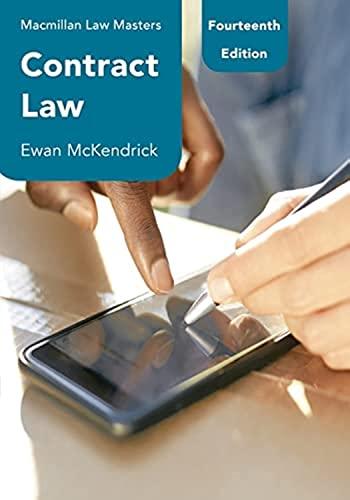Question
In 2013, the U.S. Supreme Court held in the Myriad Genetics case that a discovered human gene cannot be patented because it is naturally occurring.
In 2013, the U.S. Supreme Court held in theMyriad Genetics case that a discovered human gene cannot be patented because it is naturally occurring. In other words, discovering something that exists is not a new creation.
But what about a modified gene? Or a life form that is not naturally occurring?
Harvard's Oncomouse
A transgenic animal is one that has DNA from another species injected into its genes. New research techniques were developed in the latter 20th century to create transgenic creatures. This led to applications to patent a resulting organism. For example, in 1987, a patent was granted on a "polyploid oyster" created by artificially inducing more than one set of chromosomes. The USPTO determined patents could be issued for non-naturally occurring non-human multicellular organisms, including animals.
Harvard soon obtained a patent for the "Harvard Oncomouse," a transgenic animal. Oncomouse was artificially created by injecting an oncogene into a lab mouse to make it more susceptible to cancer. The purpose was to use Oncomouse for cancer treatment research.
The Harvard Oncomouse patent was not actively opposed in the U.S., but it was when Harvard filed for patents in other countries. Canada initially refused the patent and the patent application aroused furor in Europe. The European Patent Convention excluded inventions "contrary to the ordre public or morality." Several opponents to Harvard's European application cited this for basis to deny the patent on moral grounds because of misuse and suffering of an animal.
Eventually, the European Patent Office (EPO) decided that the usefulness of the oncomouse for important medical research outweighed the mouse's suffering.
Upjohn's Oncomouse
However, in 1992 Upjohn sought to patent a transgenic mouse modified by injecting a gene to cause it to lose its hair. The purpose was to use the mouse for research to cure human baldness. The European Patent Office rejected this patent, finding the Upjohn mouse did not overcome the barrier of being contrary to the public good and morality.
Reference: WIPO Magazine Article (2006) in Week 2 Lesson about the Oncomouse Patent Case: "Bioethics and Patent Law."
Compare: Dolly the Sheep story (in your eReserve reading this week).
PROMPT
What are the implications of the Harvard Oncomouse patent? The purpose of patents is to provide exclusivity of ownership of the invention to allow the inventor an opportunity to profit from the invention without competition. This legal protection inherently promotes innovation and creativity of new ideas which improve the quality of life and social welfare.
Discuss the following issues presented by the mice patent scenarios.
1. Should a patent be issued in any case for transgenic animal creation or modification? Why or why not?
2. Explain (in your own words) the balancing test the EPO applied in reaching 2 different decisions. The starting point was "morality" objections to the patents. What was necessary to overcome the morality objection? What should be the considerations? Would you have issued the patent in either "mouse" case? Why or why not?
Step by Step Solution
There are 3 Steps involved in it
Step: 1

Get Instant Access to Expert-Tailored Solutions
See step-by-step solutions with expert insights and AI powered tools for academic success
Step: 2

Step: 3

Ace Your Homework with AI
Get the answers you need in no time with our AI-driven, step-by-step assistance
Get Started


